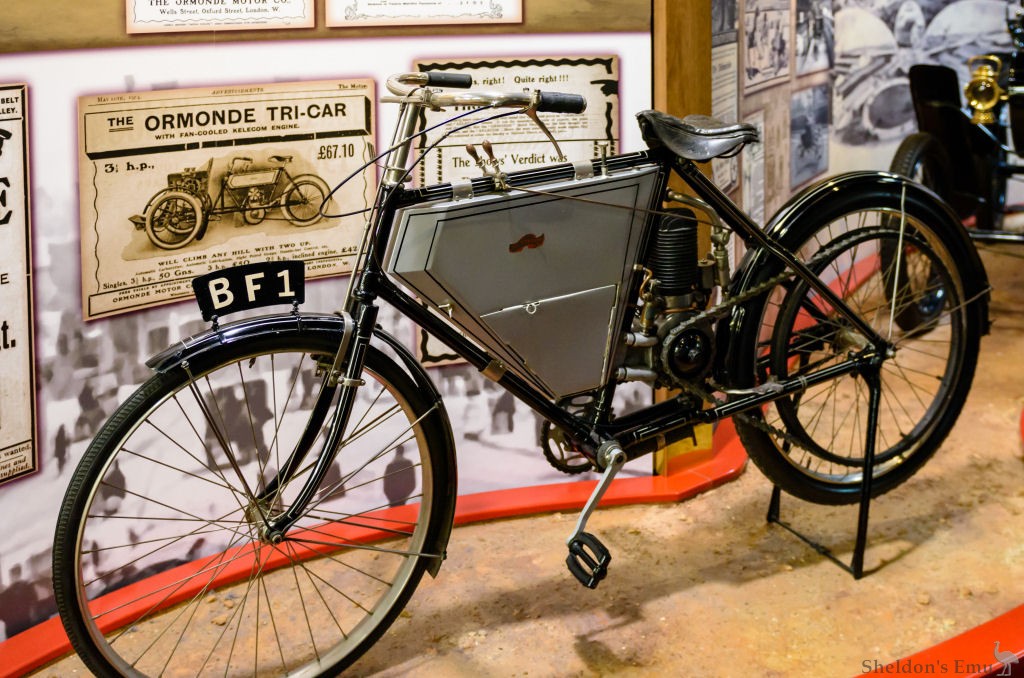



Ormonde Motor Co of Wells Street, Oxford Street, London, produced motorcycles from 1900 to 1904.
1900 The machine was a primitive fitted with a Belgian Kelecom or Antoine engine that was tucked into the space between the seat tube and the rear mudguard. The result was a reduction in the belt centres and enhanced belt-slip. The spark-plug was placed very close to the rider's thigh.
1903 Engines of 2¼ hp or 2¾ hp were offered, along with solos, tandems and a forecar.
1904 The engine position was moved to be more conventional, upright and central within the main frame loop, for the 3hp or 3½hp Kelecom engine. They also introduced a belt drive fitted with cross pins to engage with grooved cut in the engine pulley. Tandems, forecars and trailers were all listed along with the solos. Some had fan-cooled engines. Kelecom and Ormonde merged, but failed before the end of the year.
Some 9 Ormonde machines survive.
Note: The assets were bought by Taylor Gue, who had been making their frames. The following year Taylor Gue built their own machine named Veloce, which later became the Velocette.
Report from the 1902 Stanley Show
Machines are all fitted with the Ormonde special V section belt. The tank capacity is 7 quarts, capable of driving the machine 170 miles. A special indicator fitted on the outside of the tank is moved by a float in the petrol, and shows the exact quantity in the tank. The contact breaker and valve lifter are combined, working with a twisting handle. The control is effected by two levers, one for advancing sparking, and one for the throttle. Valves on the machines exhibited are all increased in size from those of last season.
Automatic lubrication is fitted, and a light gauge for the oil is fitted on back tank. Ormonde front rim brake and Bowden on the back are fitted to all machines. Prices £45.
A lady-back motor tandem is also to be seen here, fitted with a 2.75 Kelecom engine, and is worthy of an inspection by those who intend going in for this form of motoring, all the Ormonde specialities being embodied in this machine, which is listed at £60.
The Ormonde fore-carriage, selling at 12 guineas, is exceedingly well designed. It is quickly attached and detached, and on removing the front wheel of the cycle and fixing up three clamps, a cycle is converted into a three-wheeled two-seated car.
Motor Cycling, 26th November 1902
Reports from the 1903 Stanley Show:
The Ormonde Motor Co.
As might be expected, there will be many detail improvements in the 1904 Ormondes. The valves will be at the side of the cylinder, and the inlet valve will be mechanically operated; of the two, the exhaust will be nearer the front wheel. The ball release valve will be improved, the ball having a steel seating top and bottom. The flywheels will be 2 in. larger in diameter, with all the weight on the periphery. The bore and stroke of the standard pattern will be 80 x 80; also a larger type will be shown, 84 x 84. The distribution gear cogs will be smaller, to admit of more delicate adjustment in the timing. The connecting rod will be H-shaped. The sparking plug will be directly over the inlet valve. The trip hammer spindle working the two valves will be larger, rounded at the end and hollow, and will work in a gun-metal guide. The carburetter will be of the F.N. type, enlarged and improved, and will be fitted so close to the engine that there will only be the throttle between it and the inlet valve. The back belt pulley will be fitted on with short spokes, and a brake will act on this pulley. On lifting the front brake the current will be cut off. A distinct novelty will be the chain belt illustrated and described in our last issue.
The Motor Cycle, November 18th, 1903. Page 797
Stanley Show 1903
The Ormonde Company's New Chain Belt Transmission.
As the result of exhaustive experiments the Ormonde Motor Company with their customary enterprise are placing on the market for the 1904 season an entirely new system of transmission in addition to their standard belt drive. We have closely inspected the new system and it struck us as being one of the best things in transmission yet brought out. As its name suggests, the system is a combination of belt and chain. The chain-belt consists of a series of flat hinged steel plates on the inner side of which is a leather face. At each hinge there is a projecting pin which will be fitted with a steel roller on each side. The idea, as will be readily grasped from the illustration of the actual gear, is that on the engine pulley a positive drive is obtained by the rollers running in the teeth provided in the flanges of the pulley. On the driving wheel rim the chain-belt drives exactly as a flat belt. It will be quite obvious that there can be no slip whatever on the engine pulley, no matter what the conditions of the belt, be it wet or greasy, but on the driving wheel pulley there is just that necessary amount of slip available which saves the machine and tyres from the ill-effects of the explosive impulses. Especially will this form of transmission be applicable to fore-carriage and high-powered engine drives. Another advantage is that the attention it would require would be practically nil. The company will exhibit at the Stanley.
The Motor magazine, 18th November 1903
Stanley Show 1903
Sources: Graces Guide, The Motor magazine, Motor Cycling magazine.